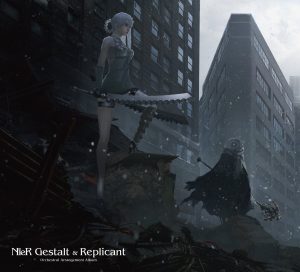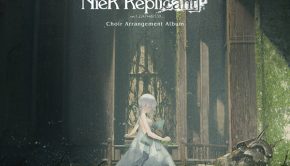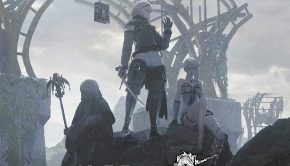NieR Gestalt and Replicant Orchestral Arrangement Album
 |
Album Title: NieR Gestalt and Replicant Orchestral Arrangement Album |
| Record Label: Square Enix Music |
|
| Catalog No.: SQEX-10673 |
|
| Release Date: September 12, 2018 |
|
| Purchase: Buy at CDJapan |
Overview
NieR Gestalt and Replicant Orchestral Arrangement Album is the first fully orchestral arrangement album for the original NieR games. It comes eight years after the release of the original soundtrack, released simultaneously with the orchestral arrangement album for the sequel game, NieR: Automata. The album has separate arrangements for individual songs, rather than medleys or suites. Although the tracks that were chosen for this album all originally featured vocals, only half of them have a choir here. The arrangements are often straightforward, but there are a few inventive arrangements and orchestrations that bring new life to the beloved score of NieR.
Body
The album starts with the original soundtrack opener, “Snow in Summer” and it essentially preserves the original arrangement and orchestration. This serves to emphasize the difference that having a full orchestra and choir can make, as that the arrangement feels much more weighty than the original. It also sounds more mature, utilizing a mixed adult chorus rather than the original children’s chorus. This coupled with some other minor changes (like different percussion) causes the track to lose some of its original otherworldliness, but is by no means made bad by this. The next track, “Song of the Ancients,” departs much more heavily from its source. The track is not molded from any of the original soundtrack versions and instead opts for a Romantic arrangement. The track first focuses on the orchestra, creating a lush soundscape with some new counterpoint that gives the track more harmonic color and sophistication over the original. Solo instruments get time to shine before bringing in the wider orchestra and choir. Since a choir cannot match the beautiful simplicity of Emi Evans’ original vocal, the arrangement instead uses the choir for power and texture. All of these elements together result in a sprawling track that feels like a journey, very different from the original but more than able to stand on its own.
The album continues with “Hills of Radiant Winds,” the first arrangement on the album not to feature the choir at all. The first half of the track is very lush and light with the melody largely handled by the strings. The other instruments dance around with various ornamentations and counterpoints, this time providing texture instead of harmonic complexity. The second half of the track is where the arrangement becomes impressive, as it ramps up the energy with added percussion and jabbing strings that create a rhythmic profile completely different from the original. This coupled with new emphasis on brass helps to create a sense of grand adventure, making for a wonderful reinterpretation. Other similar tracks on the album that don’t feature the choir are “Kainé,” “Grandma,” and the closing “Ashes of Dreams,” likely again because a choir cannot fulfill the role that Emi Evans’ vocal played in these tracks. Unfortunately the orchestra doesn’t do enough to make up for this lack in these arrangements, as they are too straightforward and similar to the originals. “Kainé” does feature a victorious ending with strong brass that feels very different, but the tracks are otherwise merely pleasant trips through the familiar melodies, lacking much new and engaging material.
The album also features three battle tracks. The first of these is “Gods Bound by Rules,” which is very similar to its original. Again the mere difference of having a full orchestra and choir is enough to set the arrangement apart, as the track is much more powerful than the original. The body of the arrangement is less busy and frenetic, a change which is perhaps necessary for clarity in the orchestral setting, yet one that does diminish the effect of the track. A nice new quiet section introduces new melody lines, though I wish these additions were more prominent towards the end. “The Dark Colossus Destroys All” is similar, starting in a straightforward manner before introducing new material in a quiet middle section (here with more classical than romantic influence) which it then brings together for the ending. The result is weaker here, but it is still a decent track. “Shadowlord” is the most different of the three, beginning only with brass, then winds, then strings which add new counterpoint. When the track reaches the battle section, it is much more dramatic and cinematic than its original counterpart, having distinct sections of varying intensity. Wonderful as this is, it is hard to overlook the lack of choir, which would have made the arrangement perfect.
Two of the tracks stand out from the rest in terms of instrumentation, and these arrangements also deviate more from their originals. “Emil” is is a slower and mournful track, though it is not based on the original “Sacrifice” version. It does not feature the choir, as a piano takes the lead. I might have liked for there to be some virtuosic flourishes on the piano to give it the feel of being a movement in a piano concerto, but the piano part is instead rather simple. Thankfully this doesn’t prevent the arrangement from having many emotional moments, and it is in addition quite beautiful and well-paced. “The Wretched Automatons” is the other album standout, surprisingly featuring a harpsichord at its center that produces a uniquely baroque feel. This baroque feel is only surface-level, extending as far as the presence of the harpsichord, the rhythms, and some common baroque melodic fragments, but as a whole, the track lacks the complex counterpoint and thematic development commonly found in baroque music. Still the first half is very fun with instruments darting in and out around the harpsichord, though the arrangement falters a bit in taking too much time to build up its layers to the tempestuous climax, where it would have been helped by having some interesting counterpoint. As it stands the arrangement is still one of the best of the album, and I would love to see future arrangements like these two tracks.
Summary
NieR Gestalt and Replicant Orchestral Arrangement Album is a solid addition to the NieR music catalog, and for better or for worse it plays out just as one would expect from a NieR orchestra album. The arrangements often introduce new melodic lines or play around with the instrumentation, though they are otherwise straightforward, with just a few arrangements take their songs in fresh new directions. It manages to come together cohesively into a single listening experience, despite having several different arrangers on the album. With most of the staple songs from the original games covered here, fans of the series should appreciate having this reason to jump back into the world of the music of the first NieR games.
Do you agree with the review and score? Let us know in the comments below!
4
Posted on June 3, 2019 by Tien Hoang. Last modified on May 31, 2019.














